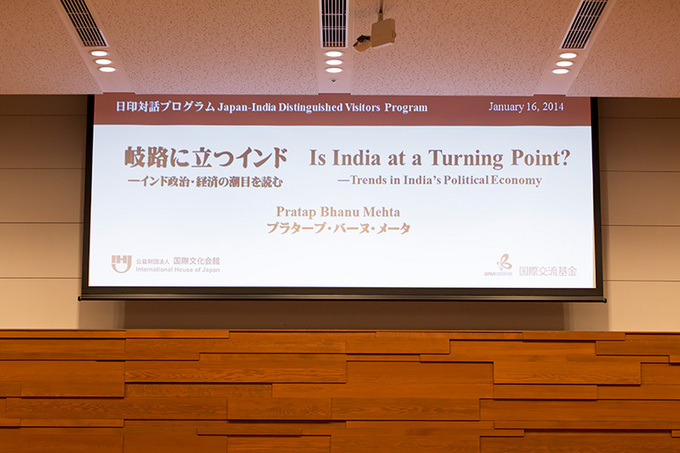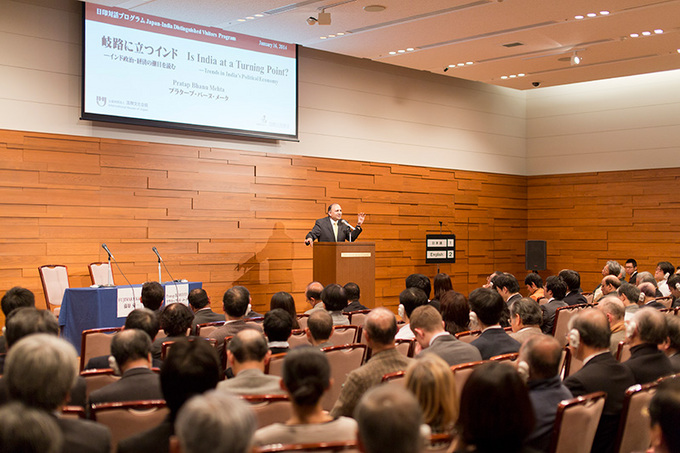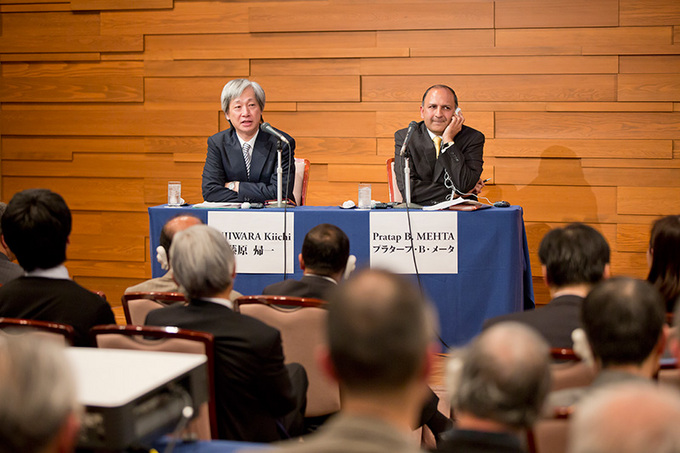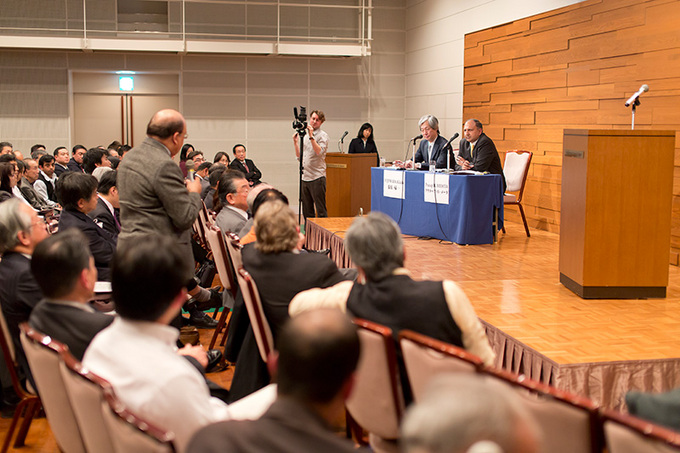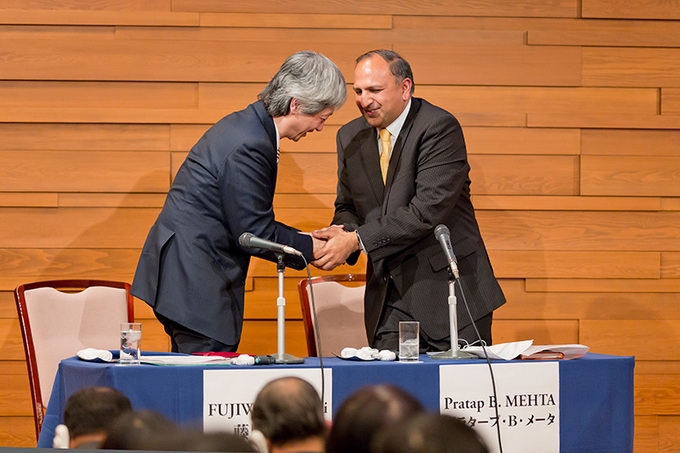Is India at a Turning Point? - Trends in India's Political Economy
Pratap Bhanu Mehta
President & Chief Executive, Centre for Policy Research
With India's Lower House election approaching in less than half a year, the eyes of the world are fixed on the future of India's political landscape.
The Japan Foundation and International House of Japan co-organize the Japan-India Distinguished Visitors Program, with the purpose of inviting eminent Indian public figures to Japan and providing a platform for continuous dialogue between the two countries. In its second year, the Program welcomed the 2013 invitee Dr. Pratap Bhanu Mehta, president of one of the most prestigious think tanks in India and whose columns regularly appear in the media, and hosted a lecture titled "Is India at a Turning Point? - Trends in India's Political Economy."
In this lecture, Dr. Mehta summed up the decade-long Congress Party government led by Prime Minister Manmohan Singh, and also dared to predict the "unpredictable" result of the elevation and its implications. In addition, Dr. Mehta analyzed where India stands at this point in time from a broad perspective, including the influence the new political situation will have on India's diplomatic and economic policies.
(The following lecture was recorded at Iwasaki Koyata Memorial Hall, International House of Japan on January 16, 2014.)
Indian democracy
One simple way to think of what is happening in India is in terms of a framework of two interrelated crises - both political and economic - that India has undergone over the past three to five years.
First off, to put things in their historical context, traditionally, India has been a very "noisy" democracy, but often there is much activity without much actual progress. As such, it is important to distinguish between long-term trends in India, and short-term "noise." However, I believe India is on the cusp of a fundamental transformation - one that other democracies have experienced in the past as well.
As we know India is a very robust and vibrant democracy. There is no doubt about how deeply entrenched democracy is India. In fact, it is one of the few places in the world where voter turnout rates are actually increasing. Furthermore, historically, India has one of the highest rates of anti-incumbency of any democracy. In addition, Indian has deepened over the years, becoming increasingly inclusive of historically marginalized groups.
However, there remains one fundamental flaw in Indian democracy. While it had become representative, it was not a very responsive democracy. The structures of the Indian state seemed to be very slow to meet the demands of the people and was very inefficient. This is not limited to business but applies also to the delivery of basic social services. While such a gap between representation and responsiveness exists to some extent in all democracies, in India's case this gap was systemic.
Principles of Indian administration
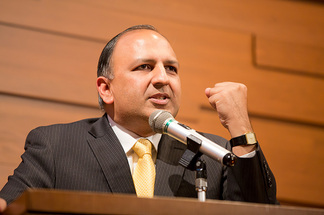 Indian administration was founded on four principles that did not suit democracy. First, the Indian system believed solely in vertical accountability, whereby members of government were only accountable to their superiors. There was very little horizontal accountability besides elections but these were only held once every five years. As such, there were very few mechanisms for addressing the inability of the government to provide a particular service.
Indian administration was founded on four principles that did not suit democracy. First, the Indian system believed solely in vertical accountability, whereby members of government were only accountable to their superiors. There was very little horizontal accountability besides elections but these were only held once every five years. As such, there were very few mechanisms for addressing the inability of the government to provide a particular service.
Second, Indian government was founded on immense secrecy, with few citizens knowing how or why particular decisions were made. Confounding this issue was the fact that the government was the primary source of important information for its citizens.
Third, India has traditionally had a very centralized state system. This remains the case today, despite various decentralization efforts.
Fourth, the government enjoyed very wide discretion in how it governed. Of course, a level of discretion is afforded to all governments and this is indeed required for effective governance, but despite the existence of formal rules, in practice the Indian government exercised a very wide range of discretionary powers that extended all the way to the most basic decisions.
Winds of change
Nonetheless, positive change is afoot in India and the four principles of administration are being fundamentally challenged. There has been greater demand for horizontal accountability and citizens have been demanding grievance redressal mechanisms. Members of government will eventually not just have to satisfy their boss, but citizens as well.
The second major revolution in India is the change in the information order of the state. The enactment of the Right to Information Act has been one of the primary legislative causes of this. It has fundamentally ensured that Government secrets can no longer exist. In fact, the reason that so many corruption scandals have recently come to light is likely not an indicator of growing corruption, rather it is due to the fact that such information is increasingly being exposed. Additionally, civil society has become a much greater source of information than it ever was. Society is now producing new forms of self-knowledge across a range domains. These factors have resulted in a shift in the balance of information from the state to society.
The third major change is the growing calls for political participation and decentralization. This demand is most pronounced in rural areas of India. On the other hand, in urban India there is much further to go, as most cities have no clear governance structure. Nevertheless, there is great demand for decentralization.
Finally, while most people recognize that any government will require discretionary power, governments will now have to justify how it exercises such discretion. Moreover, it will have to do so much more widely and satisfy all stakeholders. In a sense, there has been demand for replacing discretion with public reason.
These changes partially explain the logjam in Indian politics over the last three to five years. The traditional principles of Indian administration are collapsing, resulting in the expunging of a lot of poison from the old system, and consequently a significant loss of legitimacy. This loss of legitimacy has also compromised the state's decision-making ability. In the meantime, the struggle for the new order is continuing. The direction is clear, but the question is, what new mechanisms will be put in place that reflect the aspiration for greater horizontal accountability, for more decentralization, further access to information, and governance that engages citizens in public reason.
Growing middle class
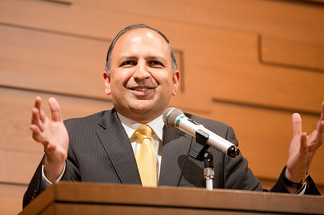 Despite the economic reforms of 1991, a number of sectors remained powerfully under state control such as natural resources; land, a particularly crucial resource in India; and arguably aspects of the financial market as well. Indeed, most of the recent corruption scandals have arisen in these sectors. The state continued to assume that it could govern these sectors with the arbitrariness it had always enjoyed. However, now, because of civil society mobilization, media, and the changing information order, the pressure to justify its actions has increased tremendously. Unfortunately the state was not used to justifying itself to the various stakeholders in good faith and gaining their trust. All governments have gone through such a transformation but the issue in India was that the state was very slow to recognize the fundamental changes in Indian society.
Despite the economic reforms of 1991, a number of sectors remained powerfully under state control such as natural resources; land, a particularly crucial resource in India; and arguably aspects of the financial market as well. Indeed, most of the recent corruption scandals have arisen in these sectors. The state continued to assume that it could govern these sectors with the arbitrariness it had always enjoyed. However, now, because of civil society mobilization, media, and the changing information order, the pressure to justify its actions has increased tremendously. Unfortunately the state was not used to justifying itself to the various stakeholders in good faith and gaining their trust. All governments have gone through such a transformation but the issue in India was that the state was very slow to recognize the fundamental changes in Indian society.
Much of this change has arisen due to the growing assertiveness of the middle class. I am actually referring to two middle classes in India - the global middle class (anybody who earns more than $10 a day PPP adjusted) or Indian upper class, at the top 8-10% of the income distribution, and the local middle class, whose income is greater than 80% percent but less than 200% of the median income. Both are growing, which has important consequences for Indian politics.
First, managing their expectations has become very complicated. Previously, most governments assumed they simply had to keep inflation low, avoid mass starvations or famine, and then build a coalition based on social identity. As incomes grow, their interface with the economy becomes increasingly complex, in forms such as greater demand for education or growing healthcare costs. However, politicians were slow to recognize that they could not craft coalitions in the same way as the past.
The second effect is that this growth increases the resources available to the government, resulting not only in a rise in opportunities for corruption, but also the possibility of the state doing more good for people. Consequently the gap between possibility and reality actually increases rather than decreases. So overall, the rise of the middle class is raising the possibility of creating new politics.
2014 general election
The practices of the Indian state had been found to be obsolete but no political parties recognized this. This was true of both the Congress Party and the principal opposition party. In any other democratic system, the opposition would have seized these issues as an opportunity to lambast the government. However, in India's case the opposition was also implicated in this system, making it difficult for people to mobilize through conventional channels of politics.
Both parties had closed systems. The Congress Party has no intraparty democracy. Similarly, while the BJP is more of an open system, given its origins in Hindu nationalism it has always been governed by a small group of organizations outside the party. Therefore, it became very hard for new entrants and social formations to find expression in these entrenched political parties.
Furthermore, events such as the gang rape incident in Delhi, which saw a breakdown in law and order, sparked serious civil society mobilization, but the inability of these movements to channel themselves through conventional political parties gave rise to fierce anti-political sentiment. This sentiment was first channeled in the anti-corruption movement, and now the AAP, or Common Man Party, has just scored a major electoral victory in Delhi.
The AAP's rise demonstrated a number of things. First it is possible to fight elections in India based on new and clean sources of funding. Older parties would justify corruption by citing the need to fund elections, which are actually more expensive than those of the United States, even in absolute terms. Secondly the AAP's presence is forcing the two main parties to respond. The passing of anti-corruption legislation and the creation of the anti-corruption Lokpal entity is a testament to the success of the AAP. Furthermore, the party has also reengaged the Indian middle class in politics, which as a highly privatized class had been distancing itself from the state apparatus.
The coming election is highly significant and different. It is being squarely fought on a new institutional architecture and on the promise of better service delivery. Even the BJP Party's candidate, Narendra Modi, despite his controversial past, is trying to present himself as a new political force. The AAP is also emphasizing its newness arguing that the BJP shares many of the institutional characteristics of the Congress Party. The coming elections will see a new range of issues discussed and will differ from past elections on two fronts. Firstly there will be greater middle class mobilization on the issue of corruption. Secondly, the parties are talking about systemic change and new institutional forms. As one of the leaders of the AAP put it, previously the debate in India was about substitutes, but now it is about finding an alternative.
Economic slowdown
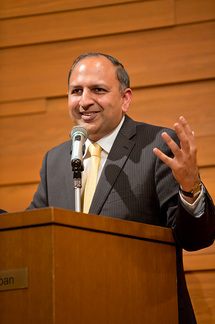 One of the big disappointments in recent years was the slow-down in the India Economy with growth rates dropping from over 8% to just under 5%. India faced an alarming current account deficit problem, but more importantly, inflation was at a historic high. So what happened to the Indian economy? Honestly speaking, there is no straightforward explanation - in fact the reason why India's economy was growing at 8% in the first place remains unclear.
One of the big disappointments in recent years was the slow-down in the India Economy with growth rates dropping from over 8% to just under 5%. India faced an alarming current account deficit problem, but more importantly, inflation was at a historic high. So what happened to the Indian economy? Honestly speaking, there is no straightforward explanation - in fact the reason why India's economy was growing at 8% in the first place remains unclear.
Nevertheless, there were a number of factors. First, despite assertions by main policymakers to the contrary, the Indian economy was not decoupled from the global economy and was affected by the global slowdown like all other emerging markets.
At the same time most economists believe India's problems were home-grown. The first of these was the standstill in domestic investment, both public and private, in the infrastructure and power industries. This was the result of the recent corruption scandals, which made decision-making very difficult. The challenges of decision-making were further compounded by the growing environmental movement among citizens and the lack of an appropriate environmental regime to respond to these demands.
Of course, infrastructure and power heavily impact the rest of the economy and many people argue that Indian inflation is the result of such supply-side constraints. As inflationary expectations set in, the reserve bank had to keep interest rates relatively high, which some argue dampened growth. Once growth slowed, the actual projects that had been invested in then became less viable, leading to much unproductive sunk capital.
There was also a fiscal deficit. In fact, the finance minister has acknowledged that the 2009 stimulus package was a major mistake. The spending itself was not the problem. The problem was it mostly took on unproductive forms, owing partly to corruption but also the government's choices. So this vicious cycle of falling growth and high inflation made Indian private investors nervous and reluctant to invest. Furthermore, as the economy slowed down, Indian consumers began buying gold, which created a current account deficit problem.
My own sense is that the worst is over and I believe this view is widely shared amongst Indian entrepreneurs. My first reason for thinking this is the growing recognition that India cannot be governed by the old rules, which, in the long-term, should promote investment. New processes and regulations have been put in place, and while it may take some time for everything to settle, over time, the limiting of the government's discretionary powers and the greater predictability of the system will be good for investors.
Secondly, whichever government comes to power, they will likely enjoy at least a short period of legitimacy. The current government has suffered such a loss of legitimacy that even when doing the right thing, it has not been afforded any trust from the public. Additionally, inflation has finally begun to taper, so there are reasons to be cautiously optimistic.
Predicting the election results
Overall, India is undergoing a large structural change and the coming election will be fought on the agenda of "newness." Even Rahul Gandhi, representing the oldest incumbent party, is trying to project himself as an outsider to the system. As such, I think it is encouraging that no one wants to claim allegiance to the old system.
In terms of results, as things stand, there is a consensus that the Congress Party will do very badly. Their credibility has been disastrously eroded. A couple of months ago it looked like the BJP would be able to score a significant enough electoral victory to at least form a stable coalition. However, the rise of the AAP has complicated things, making it very hard to predict the election results. We are entering genuinely uncharted territory. Such a three-way political contest has not been seen in India, particularly urban areas, in a very long time. There is also evidence that voter patterns are changing. For example, the AAP won the vote of both the ultra-rich and ultra-poor in the Delhi elections, contradicting conventional assumptions about identity politics in India.
Finally, my own research of elections since 2004 reveals a peculiar phenomenon whereby the party that eventually wins gains a small additional surge just before the elections commence. This suggests that when voters wish to vote a party out, in the end they opt for the party that is most likely to form an alternative stable government. If my hypothesis is true, then the BJP, as the single largest party, will gain a final surge.
The good news is that this election will be about governance; indeed a new governance architecture is beginning to take shape. However, it is unknown how well Mr. Modi of the BJP would fare as a policy-maker. Similarly, the AAP is still an entity in the making. So for both parties, no one knows what the core theme will be. In that sense, we are also in an area of uncharted territory in terms of policy. Nonetheless, I see this as an opportunity rather than a constraint. The BJP and AAP are relatively blank slates and India is facing a moment of transformation and therefore great opportunity. I am sure whoever comes to power will recognize the failures of the past five years, and understand the importance of avoiding an economic slowdown.
Following Dr. Mehta's lecture, a lively and thought-provoking Q&A session was held, with Dr. Kiichi Fujiwara, a professor at the University of Tokyo, serving as the moderator.
――Truly the beginning of something new?
The negative sentiment towards the old system certainly has some momentum to it and to some extent, the AAP's election victory in Delhi represented more a loss of faith in this system than unanimous approval for the AAP. It could perhaps even be interpreted as a protest vote. However, one factor that should ensure that the upcoming elections do bring about real change is the fact that India is a very large federal country. That makes it very difficult for a new party to gain dominance quickly. This forces even new parties to engage in the process of building consensus. India's size perhaps also explains the lack of volatility in the political system. When the direction is set, change in India happens incrementally, but there is very little reversal in direction. While the pace of change will probably be less than revolutionary, I believe we are headed in the right direction.
――The changing political landscape and India's foreign policy
It is important to India's identity to be a liberal democracy. More importantly than that India's identity has always involved a level of balance. For example it is a Western enlightenment power but is based in Asia. Similarly, it is a Hindu country but also the second most important Muslim country. I believe this social identity has a huge impact on foreign policy while also maintaining balance. India will not be a revisionist power, and, fundamentally speaking, India is committed to an open and fair architecture of the world. At least outside the sub-continent, India is a very non-threatening power. The biggest question is India's interaction with its neighbors. One line of argument is that only a BJP government can find a settlement with India's neighbors. There are two reasons. First, some believe only the BJP have the power to broker compromise. Second, people believe the BJP is much nastier as an opposition party and will be much more reasonable when in power. Overall, the structure of Indian society means we are unlikely to see a dramatic shift in India's outward policy.
――Reexamining the market economy
Certainly since the global financial crisis there has been vigorous debate about what a market economy entails and what its weaknesses are. I believe there are two issues that require further examination. In the classic conception of the market economy, the market is private and the state is public, with distinctions being based primarily on ownership. Now we have seen a big shift with many recognizing that ownership does not determine how an institution behaves or what structures of accountability it requires. Rather it is a question of the function a particular institution performs and the externalities this entails. The second issue is a more fundamental one and ties in with Larry Summers' theory of "secular stagnation." One assumption on which the market economy is predicated is that productivity growth and employment growth can occur in parallel. However, if this is in fact false, then we will need to question how much and what benefits the market economy brings with much more creativity. I do not believe the market economy should be scrapped, but if market economies produce permanent structural unemployment, then we will need to reexamine this concept.
(Photo: Kenichi Aikawa)
Pratap Bhanu Mehta
President & Chief Executive, Centre for Policy Research. His areas of research include political theory, constitutional law, society and politics in India, governance and political economy, and international affairs. He was previously a Visiting Professor of Government at Harvard University and NYU Law School and has been a member of the Government of India's National Security Advisory Board, and the World Economic Forum's Global Governance Council. As an editorial consultant to the Indian Express, his columns have also appeared in a number of national and international dailies including the Financial Times, Telegraph, International Herald Tribune, The Hindu, and Outlook. He is the recipient of the 2011 Infosys Prize for Social Sciences - Political Science.
Keywords
- Politics
- Economics/Industry
- Philosophy/Religion
- History
- Peacebuilding
- Japan
- India
- International House of Japan
- Japan-India Distinguished Visitors Program
- Manmohan Singh
- Democracy
- Hindu
- Delhi
- AAP
- Bharatiya Janata Party
- BJP
- Narendra Modi
- Rahul Gandhi
- University of Tokyo
- Kiichi Fujiwara
- Islam
- Lawrence Summers
Back Issues
- 2019.8. 6 Unraveling the Maker…
- 2018.8.30 Japanese Photography…
- 2017.6.19 Speaking of Soseki 1…
- 2017.4.12 Singing the Twilight…
- 2016.11. 1 Poetry? In Postwar J…
- 2016.7.29 The New Generation o…
- 2016.4.14 Pondering "Revitaliz…
- 2016.1.25 The Style of East As…
- 2015.9.30 Anime as (Particular…
- 2015.9. 1 The Return of a Chin…


